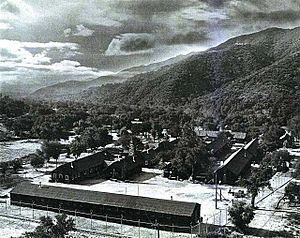Tuna Canyon Detention Station facts for kids
The Tuna Canyon Detention Station was a special place where the United States government held many people during World War II. It was a temporary camp for people, mostly Japanese Americans, who the government thought might be a risk to the country's safety. This happened after the attack on Pearl Harbor in 1941.
The camp was located in a place called Tujunga, California. Before it became a detention station, it was a camp for the Civilian Conservation Corps (CCC), which was a program that helped young men find work during the Great Depression. The government changed the CCC camp into the Tuna Canyon Detention Station very quickly after the Pearl Harbor attack.
The station opened on December 16, 1941. The first people arrived from different towns in Southern California. Tuna Canyon could hold about 300 people at a time. By the time it closed on October 31, 1943, more than 2,000 people had been held there. These included immigrants from Japan, Germany, and Italy, as well as Japanese Peruvians. Most of these people were later moved to other government camps like Fort Missoula or Fort Lincoln. After the war, the site was used as a school for young people on probation.
What Happened to the Site?
In 1960, the land where the detention station stood was sold. It was then turned into the Verdugo Hills Golf Course. The exact spots where the Tuna Canyon Detention Station and its camp buildings were located are now part of the golf course's driving range and overflow parking area.
Protecting the History
A part of the old detention site, located at 6433 West La Tuna Canyon Road, was recognized as a special historical place by the City of Los Angeles in 2013. It was named a Los Angeles Historic-Cultural Monument. This means it's an important part of the city's history that should be protected.
However, a company that builds houses, Snowball West Investments, wants to build homes on this land. They have even started a lawsuit to try and stop the land from being recognized as a historical monument. Many people believe it's important to protect this site to remember what happened there during World War II.


